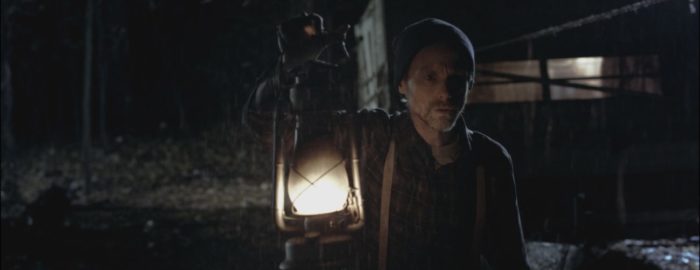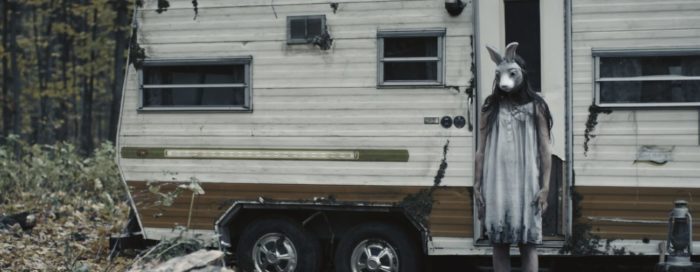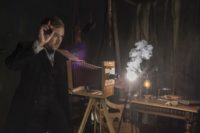It was strange that the first film I would undertake at Grimmfest’s Easter edition be Woodland Grey. I was excited to see the movie, knowing it had just won Best Feature at the Horrorhound Film Festival a few weeks ago, but it resonated with me in a rather peculiar way. I had been thinking a lot lately about purgatory and the perpetual state of being in-between worlds, something we see in a lot of supernatural thrillers and rarely acknowledge. Partially brought on by my issues with insomnia and viewing Isaac Ezban’s The Incident a week ago, Woodland Grey brought a lot of what was weighing heavily on my mind and incorporated it into the mystical forest setting and subtle narrative.

The movie begins very quietly, without so much as a word in the film for almost the first 10 minutes. We’re introduced to William (Ryan Blakely) living a Self-Reliance lifestyle, pulling carrots out of the Earth, snaring rabbits, and catching fish in a stream. Outstanding cinematography showcasing the beauty of an autumnal change is showcased in these early scenes, imbuing the feeling of a slow roll movie experience while ominously inferring that our character is less alone in these woods than initially thought. When William hears a scream close by, he rushes to find a woman unconscious on the ground.
Bringing the woman back to his camper and back from the edge of hypothermia, William’s first introduction to Emily (Jenny Raven) is more aware of the situation than in most films. Emily’s reaction to waking up in an unfamiliar place became an early highlight. Most movies gloss over this, leading to a less abrupt response, but Emily’s situational readiness helped the film establish itself in a grounded place. After a night of getting to know one another ends abruptly, Emily’s further distrust of William comes when she finds a small shed not far from his camper housing a chained up young woman (Chelsea Goldwater). Emily frees the girl, who becomes feral upon release. Emily then subdues William, perceiving him as a monster, while the girl runs off into the woods. William tells Emily that, though she’s viewing the being as a girl, that’s far from the case.
Woodland Grey leaves the natural world opting for a supernatural monster that confuses and disorients by luring its victims to receive anything they want, typically through nostalgia. The young girl embodies this woodland creature, and things only get weirder whenever William and Emily speak or dream about their desires. The two attempt to leave the woods together, finding the arduous five-hour walk far more complicated than they ever imagined. A series of nightmarish loops constantly bring William and Emily back to the camper’s location, making their escape difficult. No matter how far the two venture out, they can’t seem to get away from the trailer.

The idea feels heavily inspired by The Blair Witch Project, prompting me to wonder if Woodland Grey was moving into that territory, especially after injecting Hansel and Gretel elements into the storyline. The narrative approach also suggests the two may have a connection that extends beyond the woods, creating a lot of questions by the end of the film. Nothing is made completely clear, and the viewer is meant to interpret this series of events and its puzzling clues however they see fit.
I liked a lot of the experience Woodland Gray extends, but I think it’s slightly convoluted in how it leaves things. I usually love films that rely on the ambiguity of suggestion and compel the audience to project their personal ideas and feelings. American Psycho, Blade Runner, and the work of David Lynch are firmly featured as some of my favorites. Unfortunately, Woodland Grey plays more like a choose your own adventure, being psychologically evaluated to place the viewer into one of two groups. This becomes less about the effect and more of an either/or scenario, arguing whether a person is skeptical toward paranormal experiences by seeing them opt for the existing standard narrative or vice-versa.

As I said before, I think Woodland Grey is very much about purgatory, guilt, and grief, especially as we see the wistful aspects of the characters’ loops. It may even be suggesting through a pseudo Michael Crichton’s Sphere mentality that the characters are manifesting the pain they’re holding on to. Emily’s backstory contains a large amount of grief over her grandfather’s passing, which is why she’s come to the woods in the first place, and William has similar pain he’s holding onto as well. The spiral of dread and grief they’re caught up in is carried throughout the film and has plenty to do with how the movie ends, but it’s likely to be overshadowed by the film’s muddy conclusion, and people are going to remember that instead.
Two groups will likely emerge from showings of Woodland Grey. One group will love the film for its artsy cognizance, enjoying the ride on an emotional and psychological level. The other group will roll their eyes when the film ends, arguing that the narrative is unclear. I can see the movie being bothersome to those who want a more concise end, but I also think you have to see the forest through the trees here and consider it as a whole. On the technical end, Adam Reider’s film is a well-acted, beautifully shot film with solid ideas about loss, pain, and regrets, but its high concept doesn’t rise to the story’s limitations. For me, Woodland Grey lands strictly in the grey area, though leaning slightly more to the positive side. I appreciate the film and enjoyed the ride, but I also see it as uneven in places and wish there had been a more satisfying conclusion.
Woodland Grey is playing as a part of Grimmfest Easter in the UK this week and touring film festivals worldwide.



